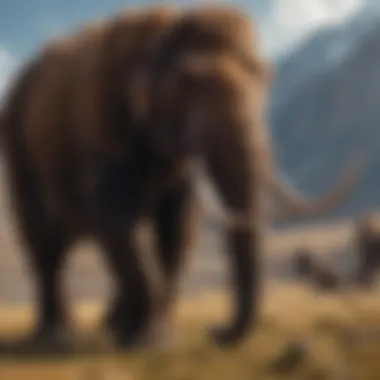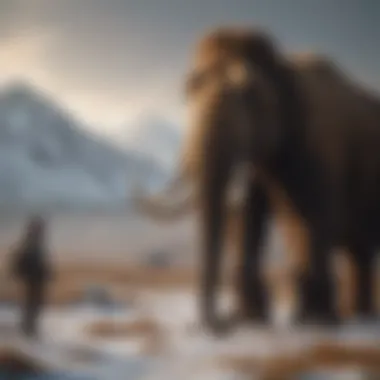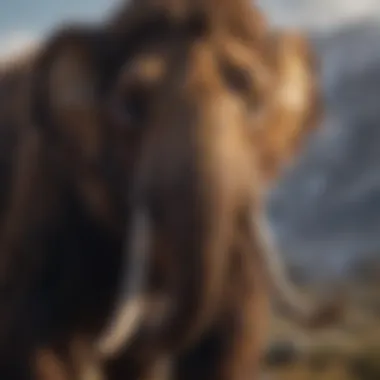Deciphering the Enigmatic Extinction of the Woolly Mammoth


Nature Topic Overview
The woolly mammoth, a majestic creature of the Ice Age, roamed the Earth thousands of years ago, captivating the imagination of scientists and enthusiasts alike. In this article, we delve into the intricate details surrounding the extinction of the woolly mammoth, exploring a myriad of factors that contributed to its ultimate disappearance from the planet. From the subtle shifts in climate patterns to the pronounced impact of humans on the environment, the story of the woolly mammoth extinction unveils a tapestry of interconnected elements that shaped the fate of this iconic prehistoric beast.
Fun Facts and Trivia
- Did you know that woolly mammoths were one of the largest mammals to have ever walked the Earth, with some reaching heights of over 13 feet at the shoulders? These gentle giants sported long, curved tusks and a furry coat ideally suited for the frigid landscapes they inhabited.
- Imagine a woolly mammoth's tusks could reach lengths of up to 16 feet, serving both as tools for foraging and weapons for defense against predators. These tusks were crucial for their survival in the harsh environments they roamed.
Wildlife Explorations
In the realm of prehistoric megafauna, the woolly mammoth held a unique place as a keystone species in its habitat. Diving into the world of ancient wildlife, we unravel intrigues about other co-existing species - from the formidable sabre-toothed tiger to the nimble woolly rhinoceros. These creatures, alongside the woolly mammoth, painted a vivid picture of the Ice Age ecosystem. Engage in interactive features like quizzes or crosswords to deepen your understanding of these fascinating beings.
Environmental Awareness
The extinction of the woolly mammoth serves as a stark reminder of the delicate balance within ecosystems and the impact of human activities on biodiversity. This narrative underscores the importance of conservation and sustainability efforts to protect present-day species from a similar fate. Discover actionable tips on how children can actively participate in nature preservation, fostering a sense of responsibility towards the environment from a young age.
DIY Nature Activities
For young explorers eager to immerse themselves in the wonders of nature, engaging in hands-on activities and experiments is a rewarding experience. Unleash your creativity with step-by-step guides for crafting nature-inspired projects or conducting experiments that showcase the marvels of the natural world. Additionally, venture outdoors and apply the knowledge gained through educational activities, turning theoretical learnings into practical adventures in the great outdoors.
Introduction
In the introductory section of this article, we embark on a journey to unravel the intricate details surrounding the extinction of the majestic woolly mammoth. This compelling narrative delves deep into the annals of history, exploring the factors that culminated in the disappearance of this iconic prehistoric creature. By shedding light on the interplay between climatic shifts and human influence, we unveil a profound tale of extinction.
Unveiling the Woolly Mammoth
Physical Characteristics
The physical characteristics of the woolly mammoth stand as a testament to its magnificence. From its imposing size to the distinctive curvature of its tusks, each aspect plays a vital role in understanding this remarkable creature. The sheer bulk of the woolly mammoth's build and the intricate pattern of its thick fur provide insights into its adaptation to harsh, ice-age environments. These features not only set the woolly mammoth apart but also offer invaluable clues to its survival strategies in a challenging world.
Habitat and Range
Exploring the habitat and range of the woolly mammoth unveils a world teeming with wonder and mystery. The vast, icy landscapes of the Pleistocene era served as the sprawling canvas for these colossal beasts, shaping their movements and behaviors. The ability of woolly mammoths to traverse challenging terrains and thrive in diverse ecosystems reflects their remarkable resilience. By dissecting their habitat and range, we gain a profound appreciation for the intricate relationship between the woolly mammoth and its environment.
Significance in Paleontology


Paleoecological Insights
Delving into the paleoecological insights offered by the woolly mammoth exposes a treasure trove of scientific knowledge. By studying the interactions between these ancient creatures and their surroundings, paleontologists unravel the dynamic tapestry of prehistoric ecology. The dietary preferences, mating habits, and migratory patterns of woolly mammoths provide crucial insights into the broader ecosystem dynamics of their era, offering a tantalizing glimpse into a bygone world.
Cultural Relevance
The cultural significance of the woolly mammoth transcends mere paleontological interest, resonating with humanity on a profound level. From ancient cave paintings to modern-day folklore, the woolly mammoth's enduring legacy sparks curiosity and imagination. The mammoth's portrayal in art, literature, and popular culture not only enriches our artistic landscape but also fosters a deep-seated connection to our distant past. By delving into the cultural relevance of these colossal creatures, we unravel the fascinating tapestry of human-animal relationships throughout history.
Climate Change Effects
In the realm of exploring the extinction of the Woolly Mammoth, the focus shifts to the pivotal aspect of climate change effects. Climate change plays a crucial role in unraveling the story of the Woolly Mammoth's demise, with its far-reaching impacts resonating through time. The interaction of shifting climates and ecological adaptations paints a vivid picture of the intricate web of circumstances that led to the extinction of this majestic creature.
Glacial Retreat Impact
Shift in Ecosystem Dynamics
Delving deeper into the implications of glacial retreat, the shift in ecosystem dynamics emerges as a significant facet in understanding the Woolly Mammoth's extinction. The alteration in ecosystems brought about by glacial retreat reshaped the playing field for diverse species, including the Mammoth. This shift disrupted the delicate balance of predator-prey relationships and vegetation distributions, ultimately impacting the survival strategies of these ancient creatures. The stark transformation in ecosystem dynamics highlighted the vulnerability of the Woolly Mammoth to external environmental changes, underscoring the fragility of its existence.
Discussing the glacial retreat impact and its contribution to the broader context of Woolly Mammoth extinction reveals a nuanced understanding of the intricate ecological interconnections at play. Highlighting the nuanced nature of ecosystem shifts sheds light on the cascading effects of environmental disturbances on prehistoric megafauna like the Mammoth. Unraveling the complexities of ecosystem changes provides a comprehensive perspective on the challenges that the Woolly Mammoth faced in an evolving landscape.
Food Source Alterations
Another critical aspect influenced by glacial retreat is the alterations in food sources for the Woolly Mammoth. As the glaciers receded and vegetation patterns shifted, the availability of suitable grazing grounds and plant species significantly changed. This discrepancy in food sources posed a significant challenge for the Mammoth population, impacting their dietary habits and nutritional intake. The dwindling resources further exacerbated the struggle for survival, pushing these ancient giants towards the brink of extinction.
Exploring the implications of food source alterations due to glacial retreat provides crucial insights into the dietary adaptations and limitations faced by the Woolly Mammoth. Examining how changes in food availability contributed to the overarching narrative of extinction offers a nuanced perspective on the interconnectedness of environmental factors in shaping the fate of prehistoric species like the Mammoth.
Temperature Fluctuations
Adaptation Challenges
When delving into the impact of temperature fluctuations on the Woolly Mammoth, the discussion naturally veers towards the adaptation challenges posed by varying climatic conditions. The Mammoth's evolution was intricately intertwined with the cold Arctic environments, making them highly susceptible to temperature fluctuations. Adapting to rapid shifts in temperature and weather patterns presented formidable challenges for the Mammoth population, testing their resilience in face of changing environmental conditions. The struggle to cope with extreme temperature variations underscored the intricate balance between adaptation and survival in the intricate ecosystem dynamics.
Exploring the theme of adaptation challenges sheds light on the intricate interplay between the Woolly Mammoth's physiological adaptations and external environmental pressures. By examining the specific hurdles faced by these ancient creatures in adapting to temperature fluctuations, a deeper understanding of their ecological niche and vulnerabilities emerges, enriching the narrative surrounding their extinction.
Survival Strategies
Among the survival strategies employed by the Woolly Mammoth, the ability to navigate temperature fluctuations stood out as a crucial aspect of their existence. Developing mechanisms to withstand harsh Arctic climates and temperature variations was vital for the Mammoth's survival in the face of changing environmental conditions. The intricate interplay between physiological adaptations and behavioral strategies showcased the Mammoth's resilience in adapting to diverse climatic challenges, reflecting their evolutionary prowess in the unforgiving tundra landscape.


Examining the survival strategies adopted by the Woolly Mammoth illuminates the intricate dynamics between environmental pressures and evolutionary responses. By dissecting the complexities of their adaptive behaviors and physiological modifications, a comprehensive narrative emerges, offering profound insights into the challenges faced by prehistoric megafauna like the Mammoth in a rapidly changing world.
Human Influence
Human activities played a crucial role in the extinction of the woolly mammoth. The impact of humans on the population decline of these majestic creatures was profound. While hunting practices and resource utilization were essential for early human survival, they inadvertently led to a rapid decrease in mammoth numbers. The utilization of mammoth resources, from food to materials, significantly contributed to their dwindling population. This intricate interplay between humans and mammoths showcases a complex narrative of coexistence and competition in prehistoric times.
Hunting Practices
Impact on Population Decline
The impact on the decline of the woolly mammoth population was primarily driven by hunting practices. Early humans relied on mammoths for sustenance and raw materials, leading to overhunting and a drastic reduction in mammoth numbers. The increased hunting pressure intensified as human populations grew, resulting in a significant decline in mammoth populations. This dynamic underscores the profound impact of human hunting practices on the delicate ecological balance of the Ice Age.
Resource Utilization
Resource utilization was a key aspect of human interaction with woolly mammoths. Humans used mammoth resources for a variety of purposes, including food, shelter, and tools. While this utilization was crucial for human survival and technological advancement, it also put immense pressure on mammoth populations. The efficient exploitation of mammoth resources exemplifies the ingenuity and resourcefulness of early human societies, albeit at the expense of the woolly mammoth's survival.
Habitat Modification
Human-driven habitat modifications further exacerbated the challenges faced by woolly mammoths. Land use transformations, such as deforestation and landscape alteration, directly impacted mammoth habitats. These changes disrupted traditional mammoth migration routes and foraging grounds, forcing mammoths into unfamiliar territories where resources were scarce. The competition for resources intensified as human populations expanded, leading to increased conflicts over territory and food sources. The pervasive influence of human activities on mammoth habitats highlights the intricate relationship between environmental change and species extinction.
Land Use Transformations
The transformation of land for human settlement and agriculture had far-reaching consequences for woolly mammoths. Deforestation and the conversion of natural landscapes into cultivated areas encroached upon traditional mammoth territories, limiting their access to crucial resources. These land use transformations irrevocably altered the dynamics of mammoth ecosystems, hastening their decline and eventual extinction. The exploitation of land for human purposes reshaped the ecological landscape in ways that were detrimental to mammoth populations.
Competition for Resources
Competition for resources was a defining factor in the interaction between humans and woolly mammoths. As human populations grew, the demand for resources intensified, leading to conflicts over territory and food sources. The competition for resources heightened the pressure on mammoth populations, exacerbating their already precarious situation. The escalating competition for limited resources further strained the delicate balance between humans and mammoths, ultimately contributing to the demise of these iconic creatures.
Mystery Surrounding Extinction
In this section, we delve deep into the enigmatic aspects surrounding the extinction of the woolly mammoth. Uncovering the mysteries that shroud the ultimate demise of this majestic creature is crucial in piecing together the puzzle of its extinction. The debate on the causes of their vanishing acts as a focal point of intrigue, drawing scholarly attention and scientific inquiry. By dissecting the various hypotheses and angles, we aim to shed light on the complex web of factors that led to the disappearance of the woolly mammoth from the face of the Earth.
Debate on Causes
Overkill Hypothesis
The Overkill Hypothesis stands as a significant pillar in the discourse around the extinction of the woolly mammoth. This theory posits that human hunting pressure played a pivotal role in driving these colossal creatures towards oblivion. The emphasis on human involvement in the annihilation of the woolly mammoth underscores the impactful relationship between ancient humans and megafauna. By exploring the nuances of this hypothesis, we can glean insights into the potential consequences of human encroachment on delicate ecosystems.


Natural Climate Shifts
Conversely, the concept of Natural Climate Shifts introduces a contrasting narrative to the discussion. This perspective underscores the influence of environmental factors on the fate of the woolly mammoth population. The oscillations in climate patterns and ecological transitions hold a key significance in unraveling the intricacies of prehistoric dynamics. By examining the impacts of natural forces on these behemoths, we gain a profound understanding of the interconnectedness between climate shifts and species survival.
Scientific Investigations
Genetic Studies
Genetic studies offer a window into the past, allowing researchers to decode the genetic blueprint of the woolly mammoth. Through genetic analysis, scientists can trace evolutionary pathways, uncover population dynamics, and unveil adaptability patterns. The integration of genetic insights into the discussion enriches our comprehension of the biological mechanisms that shaped the genetic landscape of these ancient creatures, providing valuable clues regarding their extinction.
Isotopic Analysis
Isotopic analysis serves as a powerful tool in elucidating the dietary habits and environmental adaptations of the woolly mammoth. By examining isotopic signatures preserved in mammoth specimens, researchers can glean information about their foraging behaviors, migration patterns, and habitat preferences. This analytical approach offers a holistic view of the ecological contexts in which woolly mammoths thrived, offering profound insights into their ecological interactions and dietary niches.
Legacy of the Woolly Mammoth
Impact on Biodiversity
Ecosystem Dynamics
Delving into the realm of ecosystem dynamics reveals a fascinating interplay of ecological relationships and species interconnectedness. The Woolly Mammoth's role in shaping Pleistocene landscapes exemplifies the interconnected web of life that defines biodiversity. The dynamic interactions between flora and fauna influenced by these ancient giants reflect the intricate balance of nature's evolution.
Exploring the ecosystem dynamics not only sheds light on past environments but also provides valuable insights into current conservation efforts. Analyzing the trophic cascades triggered by mammoths offers a unique perspective on the resilience and adaptability of ecosystems in response to disruptive forces.
Troop Contemplations
Amidst the grandeur of ecosystem dynamics lies the contemplation of mammoth troops and their social structures. Understanding the behavioral patterns and group dynamics of these mega-herbivores unravels fundamental principles of community organization and resource utilization. The intricate social fabric woven by mammoth herds underscores the significance of cooperation and coordination in overcoming environmental challenges.
Venturing into the realm of troop contemplations enriches our understanding of adaptive strategies and survival mechanisms within ancient mammalian societies. The legacy of troop behaviors echoes through the annals of paleontological research, offering profound insights into the intricacies of prehistoric life and its enduring impact on biodiversity.
Technological Advancements
Reviving Extinct Species
Exploring the realm of technological advancements unveils the tantalizing prospect of reviving extinct species through innovative genetic techniques. The notion of resurrecting ancient creatures such as the Woolly Mammoth bridges the gap between past and future biodiversity conservation. The revival of extinct species presents a double-edged sword, with promises of ecological restoration tempered by ethical and logistical complexities.
Diving into the intricacies of reviving extinct species forces a reflection on humanity's role in reshaping the fabric of life on Earth. The compelling case for conservation through de-extinction opens up avenues for rewilding initiatives and genetic diversity preservation, heralding a new chapter in ecological stewardship.
Cloning Ethical Concerns
Confronting the ethical concerns surrounding cloning resurrects poignant debates on scientific responsibility and biodiversity ethics. The potential ramifications of cloning long-extinct species like the Woolly Mammoth raise profound questions about ecological integrity and genetic manipulation. Balancing the pursuit of scientific curiosity with the moral imperative of species preservation requires a nuanced approach steeped in ethical considerations.
The exploration of cloning ethical concerns delves into the moral complexities of playing 'Nature's Creator,' underscoring the delicate equilibrium between technological progress and ecological prudence. The legacy of the Woolly Mammoth serves as a touchstone for ethical reflection, challenging humanity to tread carefully on the path of genetic resurrection and conservation ethics.







